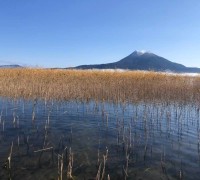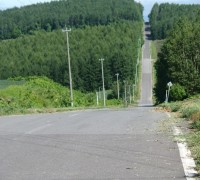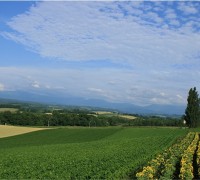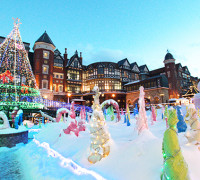The observation deck at the top of the 100m-tall Goryokaku Tower offers unobstructed views of the surrounding area, unfettered by the tall buildings one would typically expect to see in a city. Look down, and the eye is drawn to the sharp angles of the star-shaped Goryokaku below.
Inside this fortress stands a traditional Japanese building surrounded by stone walls and moats. This is a reconstruction of the magistrate’s office built in the mid-19th century. It played an important role during a turbulent period in Hakodate’s history, but was demolished just seven years after its construction. 140 years later, it was rebuilt after continued appeals from the people of the city, who had lamented the loss of this historic building.
Its story dates back to the time when Hakodate first became a port for international trade. In 1854, the ruling shogunate succumbed to pressure from the United States and ended 260 years of isolation, opening ports at Shimoda and Hakodate to foreign ships. When these foreign ships arrived in Hakodate Port, their appearance is said to have caused considerable commotion among the locals, many of whom were seeing people and ships from outside of Japan for the first time. A magistrate’s office was set up near Hakodate Port in order to deal with these ships from abroad and ensure the area’s security. However, the number of ships arriving continued to increase and fears grew that having the office so close to the port left it defenseless against bombardment.
It was therefore decided to move the magistrate’s office away from the sea and Goryokaku was built, based on the design of a French star-shaped citadel. During this period, the shogunate was sending students to Europe in order to promote Western technology and was working to adopt Western-style architecture and shipbuilding. This shift towards Western-style designs resulted in the creation of Goryokaku.
During the period of the fortress’s construction, Japan was desperate to emulate the military power of Western countries. Many countries in Asia had been colonized by Western powers, and even China, a regional superpower, had been left weakened by its defeat to the United Kingdom in the First Opium War. In response to this sense of impending crisis, the shogunate established a modern military and asked Napoleon III of France to send a number of French officers to provide instruction. As soon as these officers arrived in Tokyo, they began training the army’s samurai in the use of Western artillery and military tactics.
Six months after training began, 1868 saw major political upheaval as the shogunate fell and a new government was formed in the Meiji Restoration. Army training by French officers in Tokyo was immediately halted and Goryokaku, which had been completed only a few years previously, was handed over to the Meiji government. Dissatisfied with this sudden change of rule, the samurai of the former shogunate began to defy orders and fight back. However, they suffered one defeat after another and were driven out of Kyoto, Kanto and Tohoku. Finally, they gathered in Hokkaido and occupied Goryokaku.
Among their number was French military officer Jules Brunet, who had felt a sense of duty to support his former students in their fight against the Meiji government and renounced his status as a French soldier, despite desertion being punishable by death. Brunet’s story served as the inspiration for fictional US Army Captain Nathan Algren, played by Tom Cruise in the American movie The Last Samurai.
The Meiji government did not pursue the rebellion during the winter, and the samurai of the former shogunate who had gathered in Goryokaku declared the establishment of their own government. However, as the snow thawed the following year, the Meiji government sent troops to attack, outnumbering the samurai three-to-one. They carried guns purchased from the United States, which was in the aftermath of its own civil war. The Battle of Hakodate, the last civil war in Japan, lasted just one week as the Meiji government emerged victorious. Although many years have passed, the star-shaped Goryokaku still stands today as a monument to this turbulent period of history.
(This article was written in a project involving our company sponsored by Hokkaido District Transport Bureau)
RELATED ARTICLES
-
The Odori Park in Sapporo
-
Double-flowered cherry tree are beautifully blooming.
-
The spectacular night view of Sapporo
-
Marimo at Lake Akan
-
What is a trip for kids?
-
Beautiful Japanese Crane Tancho in Kushiro, Eastern Hokkaido
-
Ecorin Village in Eniwa: A Town of Flowers and Ecology
-
Pleasurable Farming Tours in Hokkaido
-
Experience Contemporary Ainu Art at the Foot of Mt.Hakkenzan
-
The present-day Ainu and Iomante -from the story of th...

















